JEEP WRANGLER 2007 JK / 3.G Owners Manual
Manufacturer: JEEP, Model Year: 2007, Model line: WRANGLER, Model: JEEP WRANGLER 2007 JK / 3.GPages: 467, PDF Size: 8.83 MB
Page 281 of 467
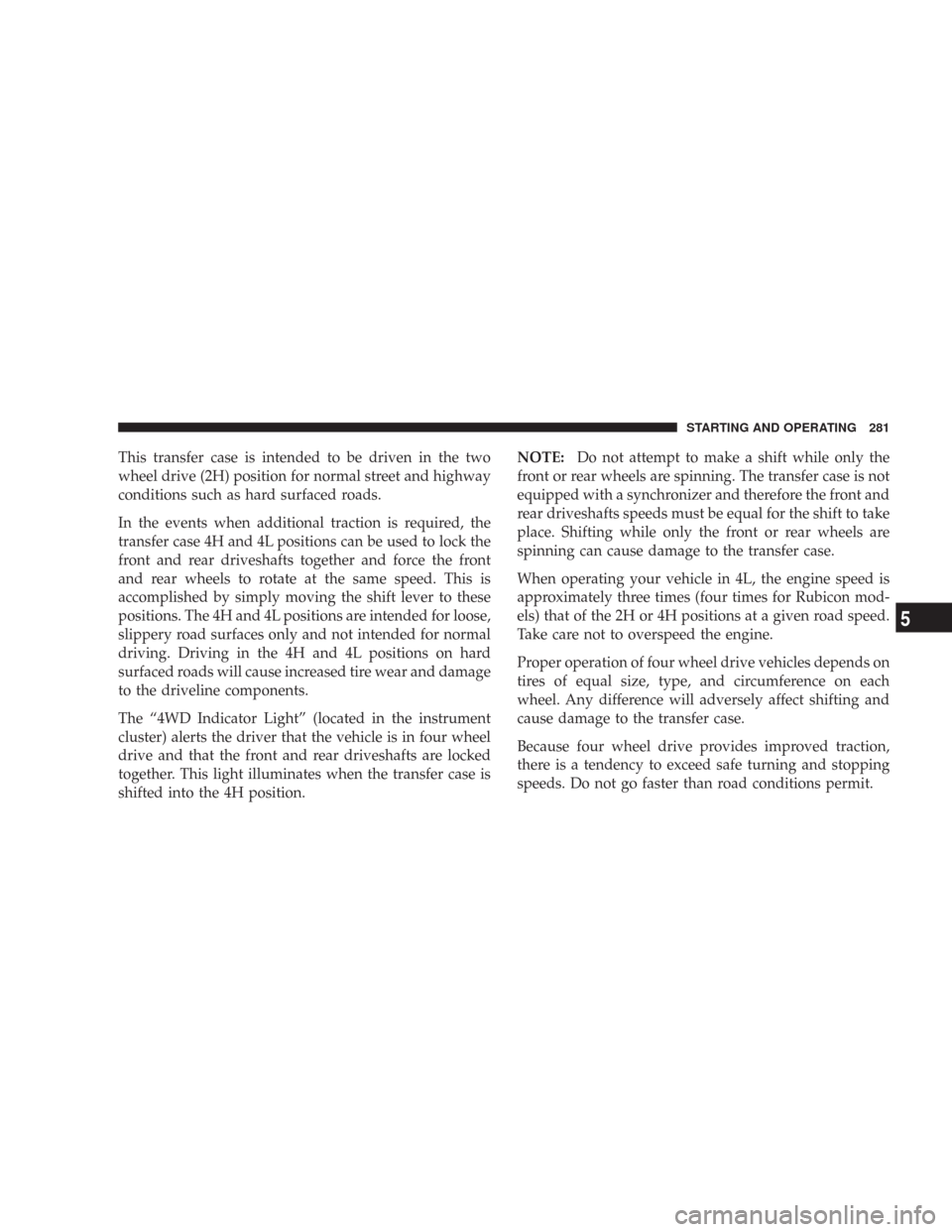
This transfer case is intended to be driven in the two
wheel drive (2H) position for normal street and highway
conditions such as hard surfaced roads.
In the events when additional traction is required, the
transfer case 4H and 4L positions can be used to lock the
front and rear driveshafts together and force the front
and rear wheels to rotate at the same speed. This is
accomplished by simply moving the shift lever to these
positions. The 4H and 4L positions are intended for loose,
slippery road surfaces only and not intended for normal
driving. Driving in the 4H and 4L positions on hard
surfaced roads will cause increased tire wear and damage
to the driveline components.
The “4WD Indicator Light” (located in the instrument
cluster) alerts the driver that the vehicle is in four wheel
drive and that the front and rear driveshafts are locked
together. This light illuminates when the transfer case is
shifted into the 4H position.NOTE:Do not attempt to make a shift while only the
front or rear wheels are spinning. The transfer case is not
equipped with a synchronizer and therefore the front and
rear driveshafts speeds must be equal for the shift to take
place. Shifting while only the front or rear wheels are
spinning can cause damage to the transfer case.
When operating your vehicle in 4L, the engine speed is
approximately three times (four times for Rubicon mod-
els) that of the 2H or 4H positions at a given road speed.
Take care not to overspeed the engine.
Proper operation of four wheel drive vehicles depends on
tires of equal size, type, and circumference on each
wheel. Any difference will adversely affect shifting and
cause damage to the transfer case.
Because four wheel drive provides improved traction,
there is a tendency to exceed safe turning and stopping
speeds. Do not go faster than road conditions permit.
STARTING AND OPERATING 281
5
Page 282 of 467
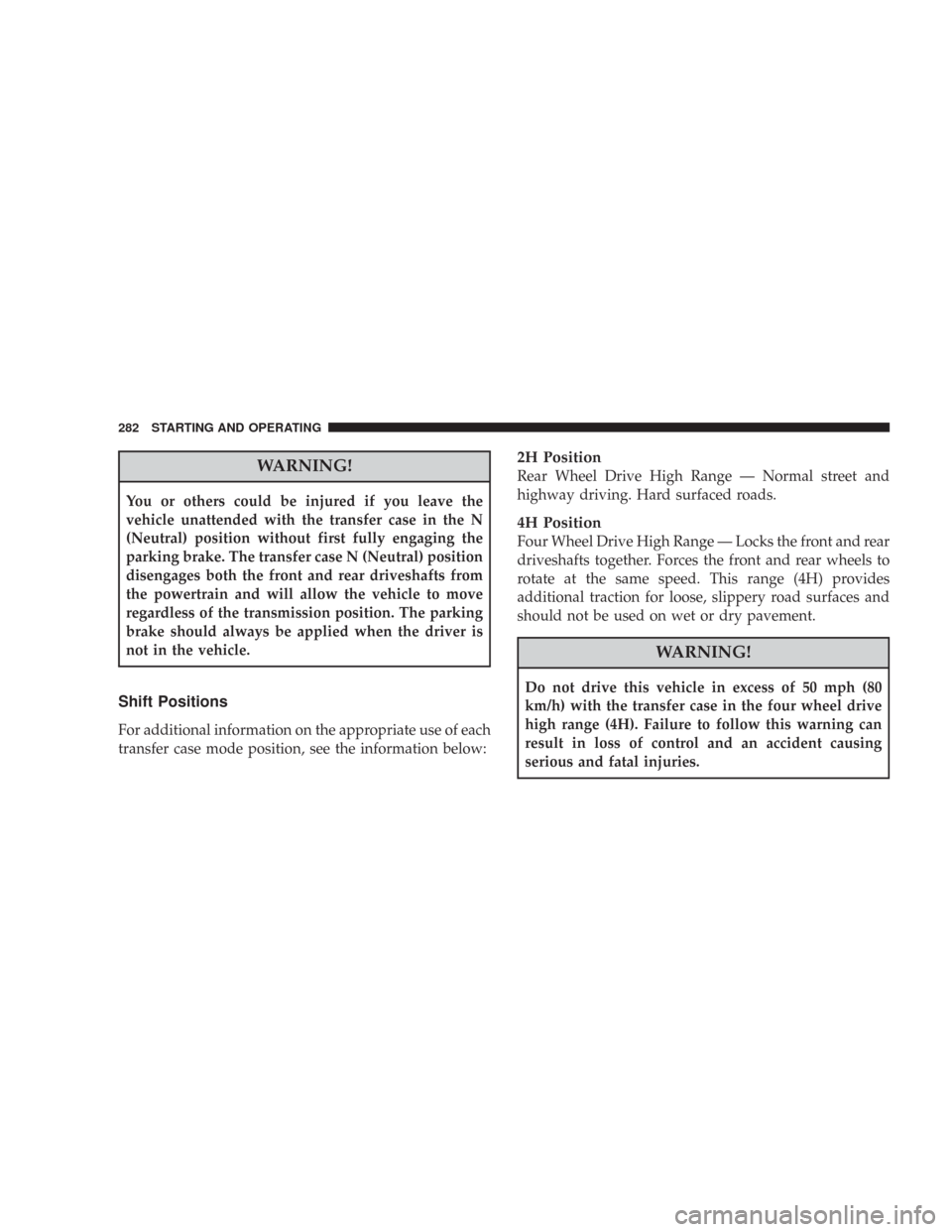
WARNING!
You or others could be injured if you leave the
vehicle unattended with the transfer case in the N
(Neutral) position without first fully engaging the
parking brake. The transfer case N (Neutral) position
disengages both the front and rear driveshafts from
the powertrain and will allow the vehicle to move
regardless of the transmission position. The parking
brake should always be applied when the driver is
not in the vehicle.
Shift Positions
For additional information on the appropriate use of each
transfer case mode position, see the information below:
2H Position
Rear Wheel Drive High Range — Normal street and
highway driving. Hard surfaced roads.
4H Position
Four Wheel Drive High Range — Locks the front and rear
driveshafts together. Forces the front and rear wheels to
rotate at the same speed. This range (4H) provides
additional traction for loose, slippery road surfaces and
should not be used on wet or dry pavement.
WARNING!
Do not drive this vehicle in excess of 50 mph (80
km/h) with the transfer case in the four wheel drive
high range (4H). Failure to follow this warning can
result in loss of control and an accident causing
serious and fatal injuries.
282 STARTING AND OPERATING
Page 283 of 467
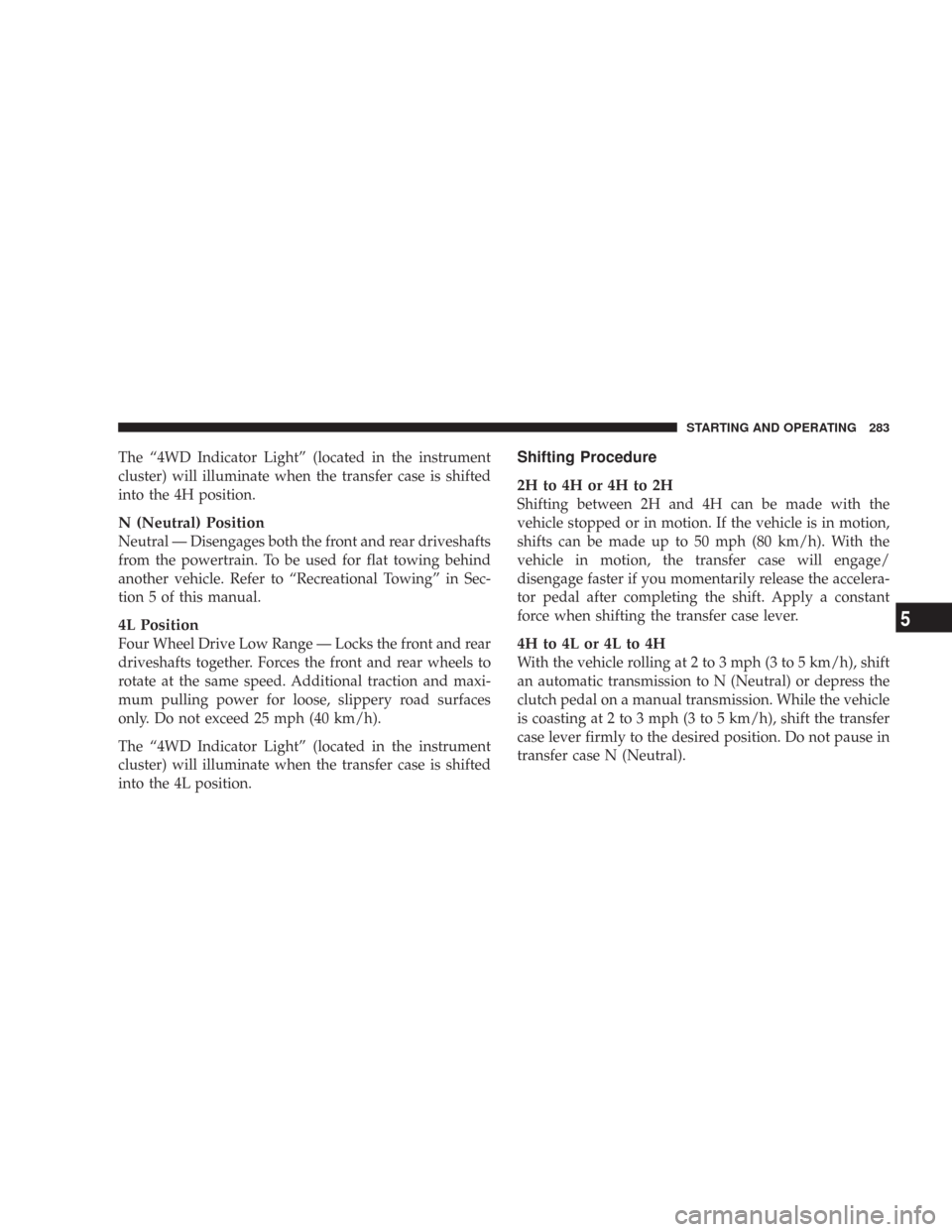
The “4WD Indicator Light” (located in the instrument
cluster) will illuminate when the transfer case is shifted
into the 4H position.
N (Neutral) Position
Neutral — Disengages both the front and rear driveshafts
from the powertrain. To be used for flat towing behind
another vehicle. Refer to “Recreational Towing” in Sec-
tion 5 of this manual.
4L Position
Four Wheel Drive Low Range — Locks the front and rear
driveshafts together. Forces the front and rear wheels to
rotate at the same speed. Additional traction and maxi-
mum pulling power for loose, slippery road surfaces
only. Do not exceed 25 mph (40 km/h).
The “4WD Indicator Light” (located in the instrument
cluster) will illuminate when the transfer case is shifted
into the 4L position.
Shifting Procedure
2H to 4H or 4H to 2H
Shifting between 2H and 4H can be made with the
vehicle stopped or in motion. If the vehicle is in motion,
shifts can be made up to 50 mph (80 km/h). With the
vehicle in motion, the transfer case will engage/
disengage faster if you momentarily release the accelera-
tor pedal after completing the shift. Apply a constant
force when shifting the transfer case lever.
4H to 4L or 4L to 4H
With the vehicle rolling at 2 to 3 mph (3 to 5 km/h), shift
an automatic transmission to N (Neutral) or depress the
clutch pedal on a manual transmission. While the vehicle
is coasting at 2 to 3 mph (3 to 5 km/h), shift the transfer
case lever firmly to the desired position. Do not pause in
transfer case N (Neutral).
STARTING AND OPERATING 283
5
Page 284 of 467
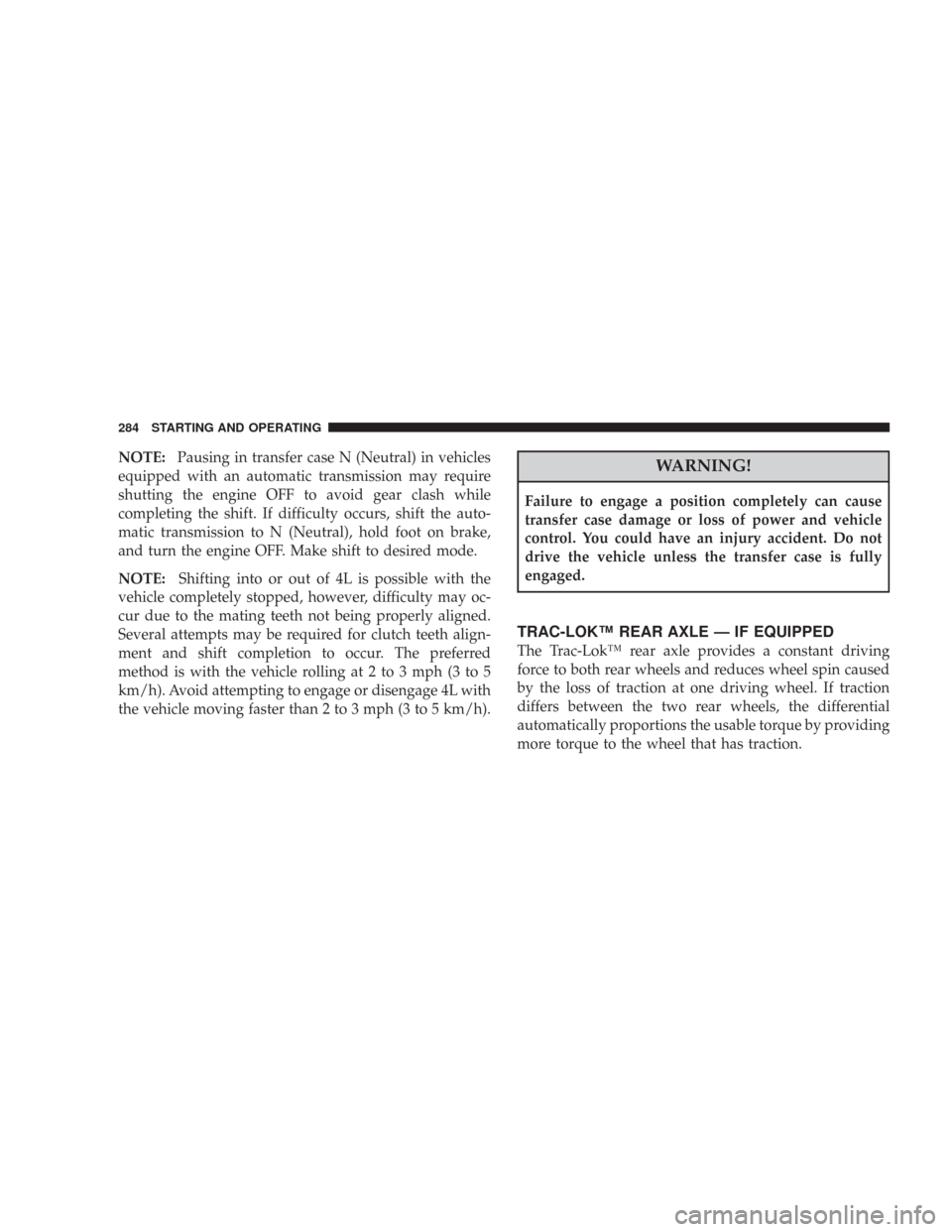
NOTE:Pausing in transfer case N (Neutral) in vehicles
equipped with an automatic transmission may require
shutting the engine OFF to avoid gear clash while
completing the shift. If difficulty occurs, shift the auto-
matic transmission to N (Neutral), hold foot on brake,
and turn the engine OFF. Make shift to desired mode.
NOTE:Shifting into or out of 4L is possible with the
vehicle completely stopped, however, difficulty may oc-
cur due to the mating teeth not being properly aligned.
Several attempts may be required for clutch teeth align-
ment and shift completion to occur. The preferred
method is with the vehicle rolling at 2 to 3 mph (3 to 5
km/h). Avoid attempting to engage or disengage 4L with
the vehicle moving faster than 2 to 3 mph (3 to 5 km/h).WARNING!
Failure to engage a position completely can cause
transfer case damage or loss of power and vehicle
control. You could have an injury accident. Do not
drive the vehicle unless the transfer case is fully
engaged.
TRAC-LOK™ REAR AXLE — IF EQUIPPED
The Trac-Lok™ rear axle provides a constant driving
force to both rear wheels and reduces wheel spin caused
by the loss of traction at one driving wheel. If traction
differs between the two rear wheels, the differential
automatically proportions the usable torque by providing
more torque to the wheel that has traction.
284 STARTING AND OPERATING
Page 285 of 467
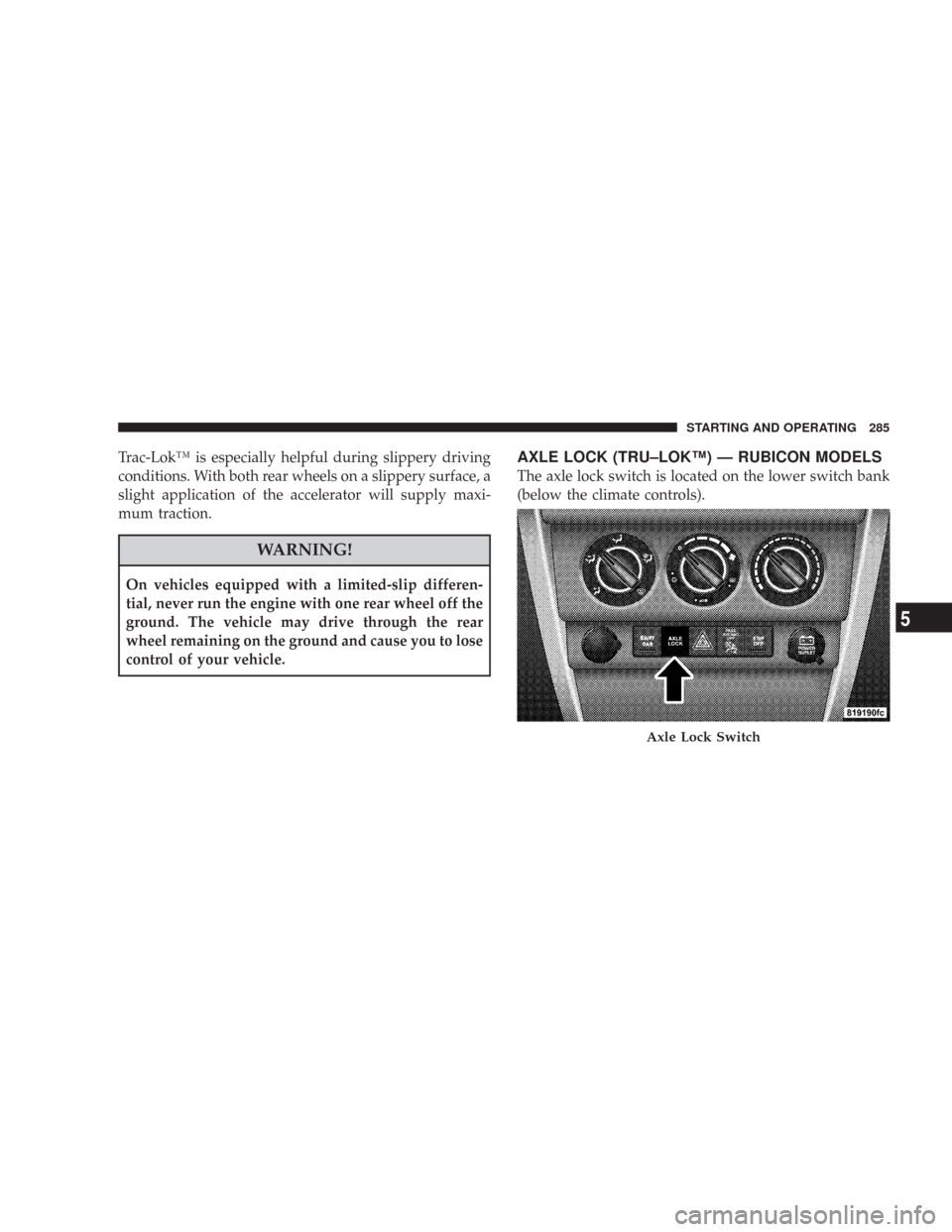
Trac-Lok™ is especially helpful during slippery driving
conditions. With both rear wheels on a slippery surface, a
slight application of the accelerator will supply maxi-
mum traction.
WARNING!
On vehicles equipped with a limited-slip differen-
tial, never run the engine with one rear wheel off the
ground. The vehicle may drive through the rear
wheel remaining on the ground and cause you to lose
control of your vehicle.
AXLE LOCK (TRU–LOK™) — RUBICON MODELS
The axle lock switch is located on the lower switch bank
(below the climate controls).
Axle Lock Switch
STARTING AND OPERATING 285
5
Page 286 of 467
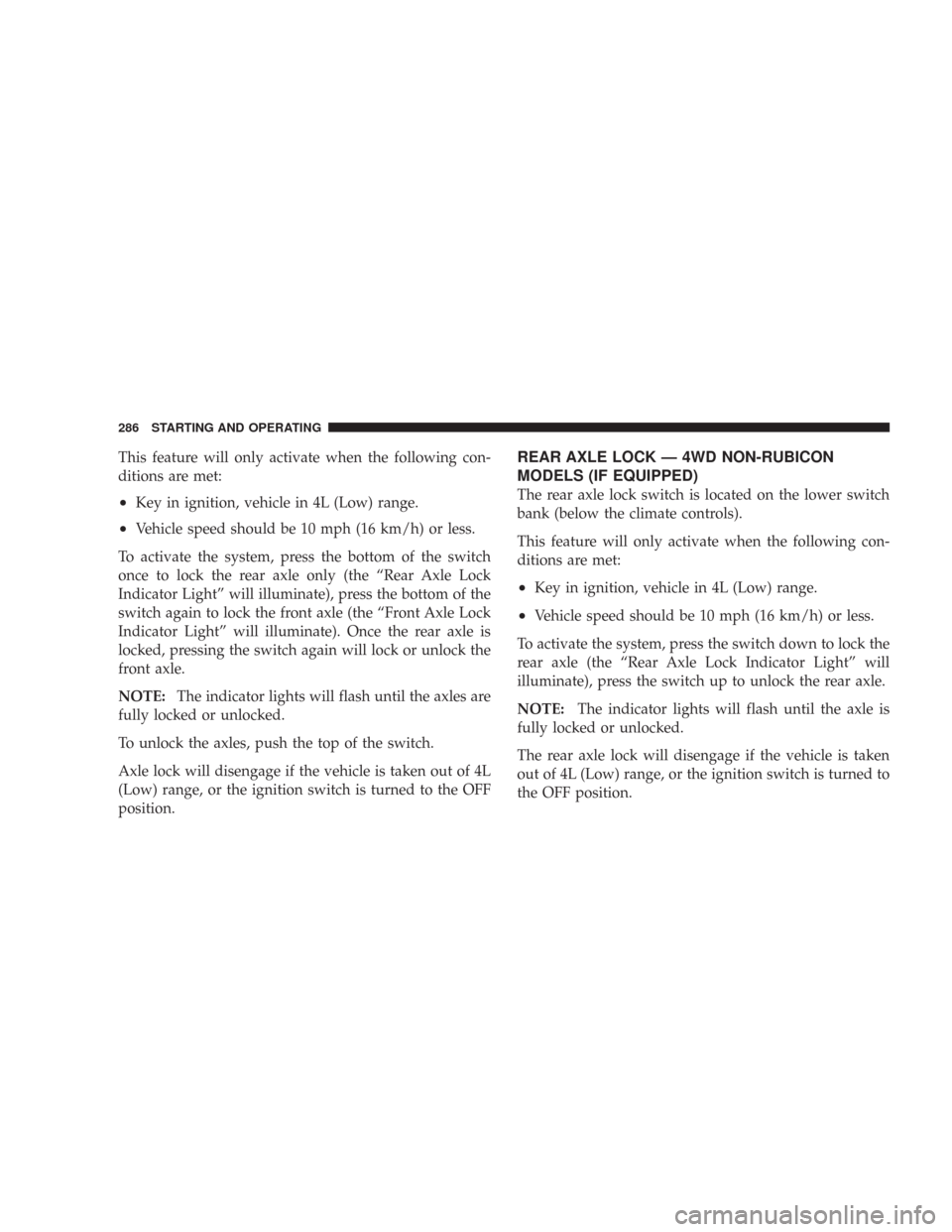
This feature will only activate when the following con-
ditions are met:
•Key in ignition, vehicle in 4L (Low) range.
•Vehicle speed should be 10 mph (16 km/h) or less.
To activate the system, press the bottom of the switch
once to lock the rear axle only (the “Rear Axle Lock
Indicator Light” will illuminate), press the bottom of the
switch again to lock the front axle (the “Front Axle Lock
Indicator Light” will illuminate). Once the rear axle is
locked, pressing the switch again will lock or unlock the
front axle.
NOTE:The indicator lights will flash until the axles are
fully locked or unlocked.
To unlock the axles, push the top of the switch.
Axle lock will disengage if the vehicle is taken out of 4L
(Low) range, or the ignition switch is turned to the OFF
position.
REAR AXLE LOCK — 4WD NON-RUBICON
MODELS (IF EQUIPPED)
The rear axle lock switch is located on the lower switch
bank (below the climate controls).
This feature will only activate when the following con-
ditions are met:
•Key in ignition, vehicle in 4L (Low) range.
•Vehicle speed should be 10 mph (16 km/h) or less.
To activate the system, press the switch down to lock the
rear axle (the “Rear Axle Lock Indicator Light” will
illuminate), press the switch up to unlock the rear axle.
NOTE:The indicator lights will flash until the axle is
fully locked or unlocked.
The rear axle lock will disengage if the vehicle is taken
out of 4L (Low) range, or the ignition switch is turned to
the OFF position.
286 STARTING AND OPERATING
Page 287 of 467
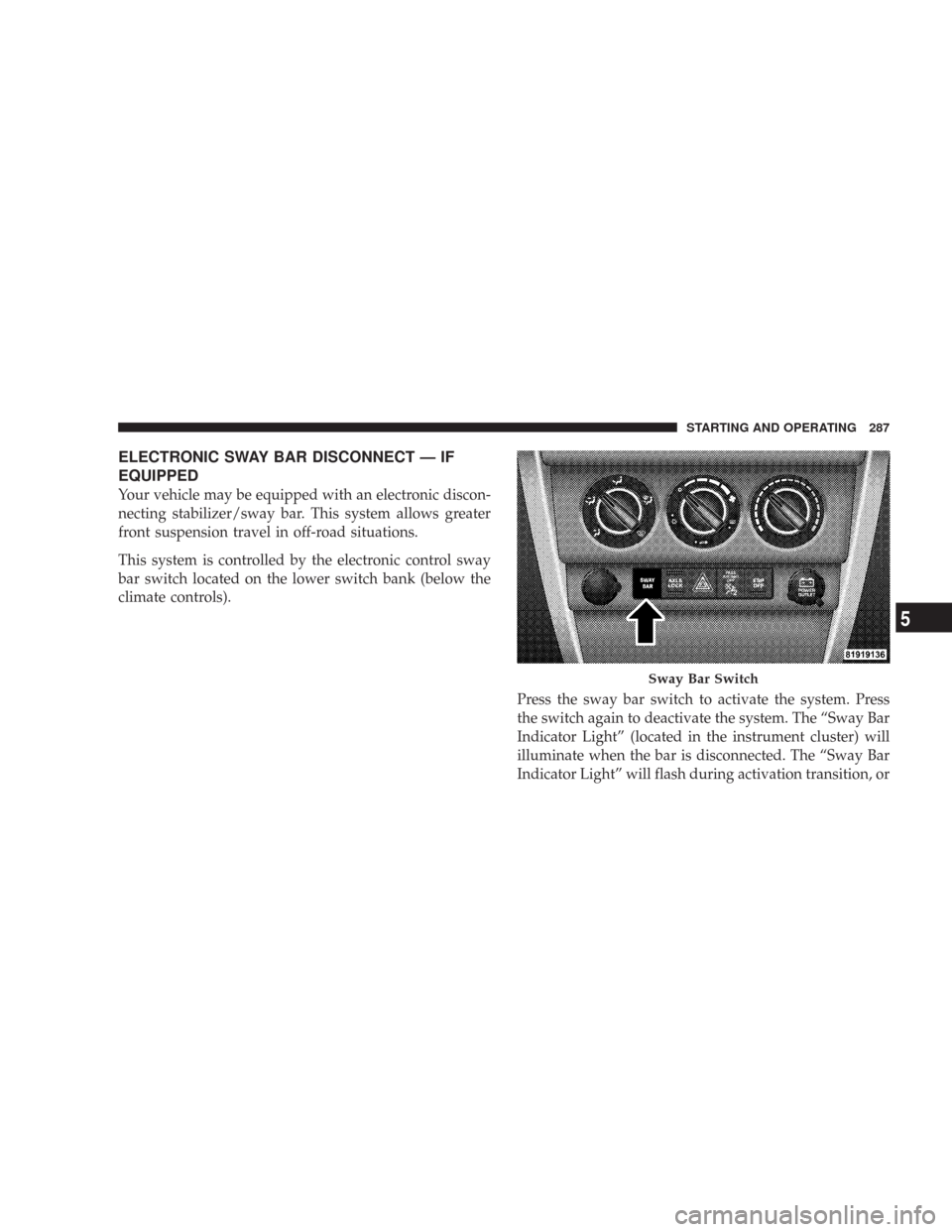
ELECTRONIC SWAY BAR DISCONNECT — IF
EQUIPPED
Your vehicle may be equipped with an electronic discon-
necting stabilizer/sway bar. This system allows greater
front suspension travel in off-road situations.
This system is controlled by the electronic control sway
bar switch located on the lower switch bank (below the
climate controls).
Press the sway bar switch to activate the system. Press
the switch again to deactivate the system. The “Sway Bar
Indicator Light” (located in the instrument cluster) will
illuminate when the bar is disconnected. The “Sway Bar
Indicator Light” will flash during activation transition, or
Sway Bar Switch
STARTING AND OPERATING 287
5
Page 288 of 467
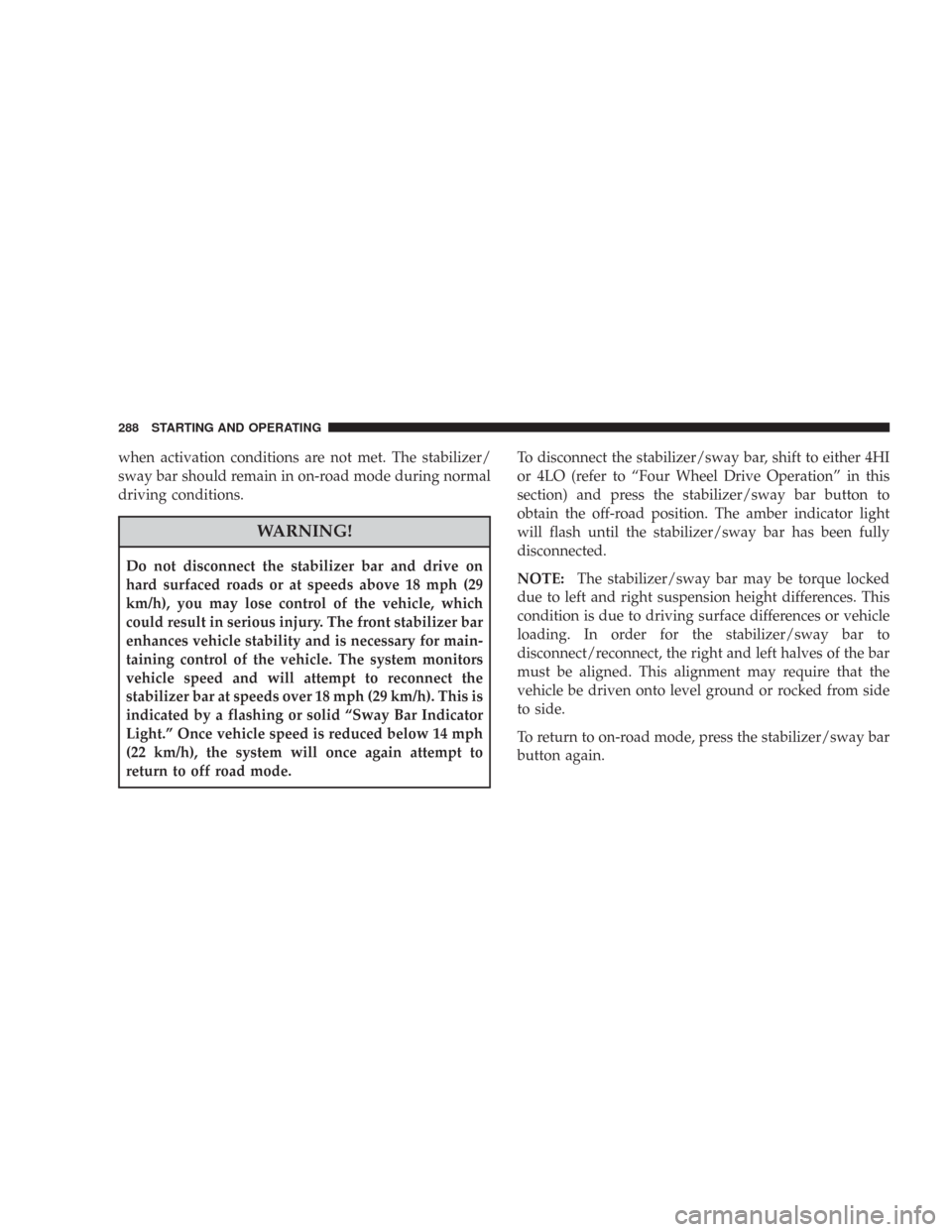
when activation conditions are not met. The stabilizer/
sway bar should remain in on-road mode during normal
driving conditions.
WARNING!
Do not disconnect the stabilizer bar and drive on
hard surfaced roads or at speeds above 18 mph (29
km/h), you may lose control of the vehicle, which
could result in serious injury. The front stabilizer bar
enhances vehicle stability and is necessary for main-
taining control of the vehicle. The system monitors
vehicle speed and will attempt to reconnect the
stabilizer bar at speeds over 18 mph (29 km/h). This is
indicated by a flashing or solid “Sway Bar Indicator
Light.” Once vehicle speed is reduced below 14 mph
(22 km/h), the system will once again attempt to
return to off road mode.To disconnect the stabilizer/sway bar, shift to either 4HI
or 4LO (refer to “Four Wheel Drive Operation” in this
section) and press the stabilizer/sway bar button to
obtain the off-road position. The amber indicator light
will flash until the stabilizer/sway bar has been fully
disconnected.
NOTE:The stabilizer/sway bar may be torque locked
due to left and right suspension height differences. This
condition is due to driving surface differences or vehicle
loading. In order for the stabilizer/sway bar to
disconnect/reconnect, the right and left halves of the bar
must be aligned. This alignment may require that the
vehicle be driven onto level ground or rocked from side
to side.
To return to on-road mode, press the stabilizer/sway bar
button again.
288 STARTING AND OPERATING
Page 289 of 467
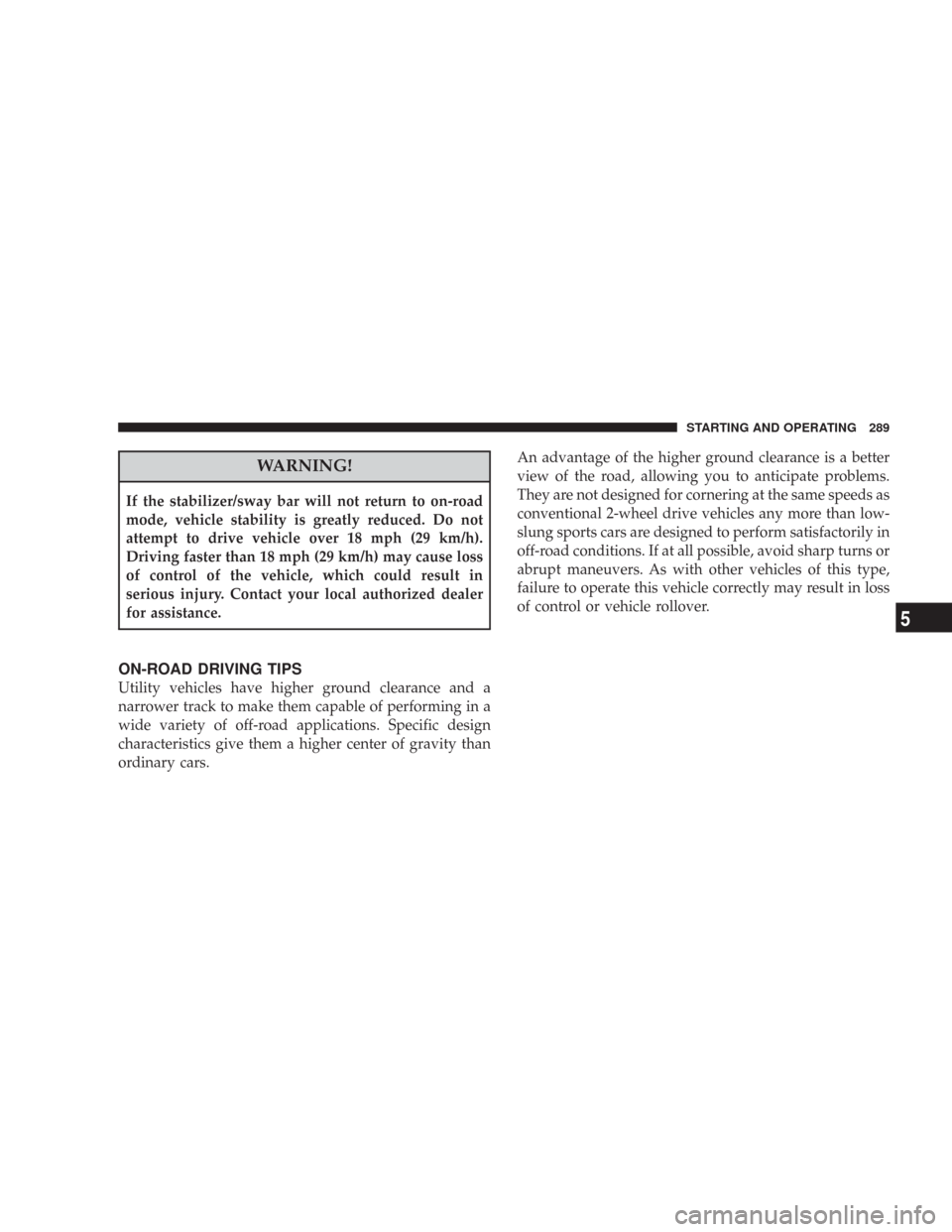
WARNING!
If the stabilizer/sway bar will not return to on-road
mode, vehicle stability is greatly reduced. Do not
attempt to drive vehicle over 18 mph (29 km/h).
Driving faster than 18 mph (29 km/h) may cause loss
of control of the vehicle, which could result in
serious injury. Contact your local authorized dealer
for assistance.
ON-ROAD DRIVING TIPS
Utility vehicles have higher ground clearance and a
narrower track to make them capable of performing in a
wide variety of off-road applications. Specific design
characteristics give them a higher center of gravity than
ordinary cars.An advantage of the higher ground clearance is a better
view of the road, allowing you to anticipate problems.
They are not designed for cornering at the same speeds as
conventional 2-wheel drive vehicles any more than low-
slung sports cars are designed to perform satisfactorily in
off-road conditions. If at all possible, avoid sharp turns or
abrupt maneuvers. As with other vehicles of this type,
failure to operate this vehicle correctly may result in loss
of control or vehicle rollover.
STARTING AND OPERATING 289
5
Page 290 of 467
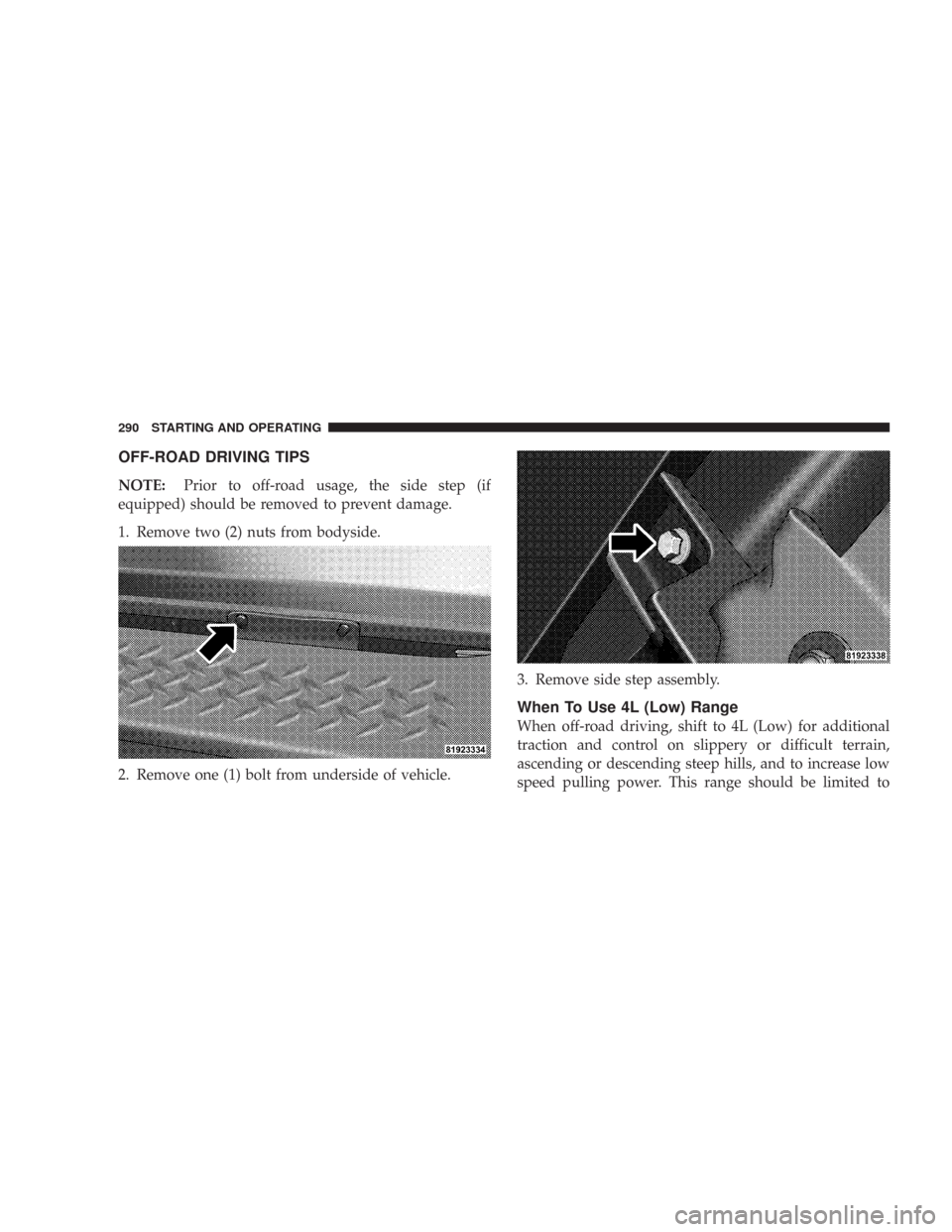
OFF-ROAD DRIVING TIPS
NOTE:Prior to off-road usage, the side step (if
equipped) should be removed to prevent damage.
1. Remove two (2) nuts from bodyside.
2. Remove one (1) bolt from underside of vehicle.3. Remove side step assembly.
When To Use 4L (Low) Range
When off-road driving, shift to 4L (Low) for additional
traction and control on slippery or difficult terrain,
ascending or descending steep hills, and to increase low
speed pulling power. This range should be limited to
290 STARTING AND OPERATING